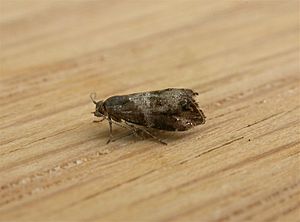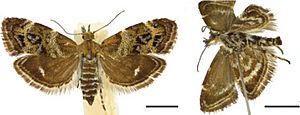Small thistle moth facts for kids
Quick facts for kids Small thistle moth |
|
|---|---|
 |
|
 |
|
| Scientific classification | |
| Kingdom: | |
| Phylum: | |
| Class: | |
| Order: | |
| Family: |
Choreutidae
|
| Genus: |
Tebenna
|
| Species: |
T. micalis
|
| Binomial name | |
| Tebenna micalis (Mann, 1857)
|
|
| Synonyms | |
|
|
The Tebenna micalis is a small moth, often called the small thistle moth. You can find this type of moth all over the world! It belongs to a group of moths called Choreutidae. A scientist named Joseph Johann Mann first officially described this moth in 1857.
Contents
About the Small Thistle Moth
This moth is quite small. Its wingspan (the distance from one wingtip to the other) is about 13 millimeters. That's about half an inch! It looks a lot like another moth called Tebenna gnaphaliella, which lives in North America.
You can usually spot these moths flying between June and August. They are attracted to lights at night. During the day, you might see them resting on the flowers of plants they like to eat.
What They Eat: Larvae and Plants
The young moths, called larvae (or caterpillars), eat plants from the Asteraceae family. They are known as leaf miners. This means they live inside the leaves of plants, eating the soft parts. As they eat, they create a blotch-like pattern on the leaf. They also leave behind their waste, called frass, inside the mine.
Sometimes, a larva might leave one leaf mine and start a new one on another part of the plant. As they grow older, the larvae might live freely on the leaf. They often spin a small web to protect themselves.
Some of the plants these larvae like to eat include:
- Common fleabane (Pulicaria dysenterica) in the United Kingdom.
- Capeweed (Arctotheca calendula), spear thistle (Cirsium vulgare), horseweed (Erigeron canadensis), cotton thistle (Onopordum acanthium), and golden everlasting (Xerochrysum bracteatum) in Australia.
- Globe artichoke (Cynara scolymus) in Réunion.
Life Cycle: Pupating
When the larvae are ready to change into adult moths, they pupate. This means they form a cocoon. For the small thistle moth, the larvae make a spindle-shaped cocoon. They usually attach this cocoon to the underside of a leaf on their host plant. Inside the cocoon, the larva transforms into an adult moth.
Where They Live
The small thistle moth is found in many parts of the world.
In Europe, you can find them south of a line that goes through Ireland, Great Britain, France, and Slovakia. In Britain, they are considered an "immigrant" species. This means they don't always live there permanently but sometimes fly over from other places. They were first seen in Britain in the 1980s.
Outside of Europe, these moths have been recorded in many other regions, including:
- China (in areas like Henan, Hubei, Jiangxi, Tibet, and Zhejiang)
- Nepal
- Russia
- Japan (Honshu, Ryukyu Islands)
- Afghanistan
- Tajikistan
- Uzbekistan
- Turkmenistan
- Canary Islands
- North Africa
- Arabia
- Asia Minor
- Zakavkazye
- Iran
- Lebanon
- New Zealand
- And other regions like the Oriental, Ethiopian, Australian, and Nearctic areas.
Types of Small Thistle Moths
There are two known types, or subspecies, of Tebenna micalis:
- Tebenna micalis micalis
- Tebenna micalis dialecta (This type is found in Madagascar, Mauritius, Namibia, and South Africa, and was described in 1985 by Diakonoff.)
See also
 In Spanish: Tebenna micalis para niños
In Spanish: Tebenna micalis para niños

